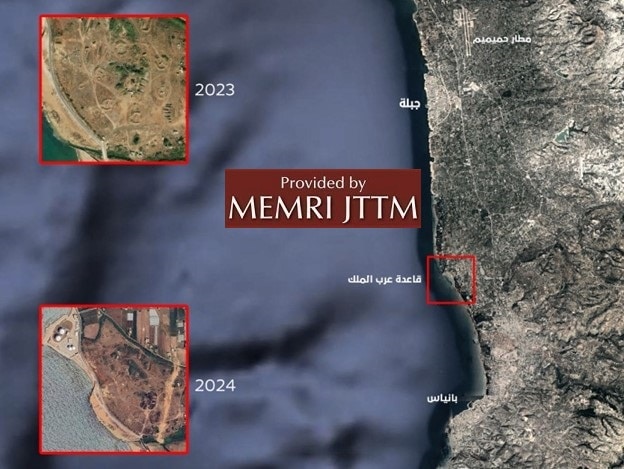The following report is now a complimentary offering from MEMRI's Jihad and Terrorism Threat Monitor (JTTM). For JTTM subscription information, click here.
On August 12, 2024, the pro-Syrian opposition outlet Syria TV reported on its website that Iran's Islamic Revolutionary Guard Corps (IRGC) has finished building its first naval base between the cities of Jableh and Baniyas on the Syrian coastline.
The project, which started a year ago, aims at boosting the Iranian military presence in Syria, with weaponry including missiles and drones.
Citing unnamed sources, the report claimed that the Iranian coastal base was built in collaboration with Russia and under military cover provided by the Syrian Regime's army.
"The work in the base began in December 2023 under the supervision of Brigadier General Reza Zarei of the Iranian Revolutionary Guards' naval force, who was assassinated by Israel along with a leader of the Lebanese Hizbullah militia in an airstrike targeting their residence on a farm on the eastern outskirts of the city of Baniyas on March 1," said the report.
Following Zarei's death, the project was assigned to "the Brigadier General of the Fifth Region, Command of the Revolutionary Guards Naval Forces, Hamid Rezazadeh, nicknamed Haj Gholam."
The report said the sources further noted that Gholam is also in charge of an Iranian-Lebanese unit whose mission is to monitor navigation in the Mediterranean Sea, and in particular the movement of the American fleet and Western warships.
This unit consists of 20 operatives, including IRGC officers and experts from Lebanese Hizbullah.
The Base Location
Identifying the precise location of the base, the report said it is located "between the cities of Jableh and Baniyas on the Syrian coast, near the Arab Al-Malik beach, as part of an air defense barracks belonging to the Syrian regime army."
The report said that "Unit 840 of the Quds Force of the Revolutionary Guards, in addition to Unit 102 of Hizbullah, are responsible for securing and guarding military shipments, warehouses and other buildings inside the base."
Aerial images, reportedly from Google Maps, were also included. According to the report, the images show that during April 2024 the Syrian Army evacuated the base, which used to house its air defense forces.
"Comparing the latest images with images from the same source in the second quarter of 2023 shows that the Syrian regime has evacuated the radar system and the Sam-5 missile launch batteries, in addition to making minor changes to the base's structure, except for the underground 'hangars', which the Revolutionary Guards are likely using now for storage and management purposes."

"Russia Provided Assistance"
Highlighting that Russian forces in Syria have provided cover for many Iranian operations, including smuggling military equipment and weapons into Syria, the report noted that Iranian aircraft linked to the IRGC was received at the Russia-operated Hmeimim airbase and was allowed to store its cargo in the base's warehouses.
"The Iranian aircraft landed in Hmeimim after Israel kept Aleppo and Damascus airports out of service for a long time, through a series of successive attacks at the end of last year and the beginning of this year. According to the sources, one of the shipments that was stored in Hmeimim last February, before being transferred to an unknown destination, included two Siraj warships, which are fast attack boats designed for launching anti-ship missiles and piracy operations, produced by the Iranian Ministry of Defense," said the report.
It further claimed that "earlier this year, Iran equipped this type of fast warship vessel with launch- platforms for missiles of various types and ranges."
The full text of this post is available to subscribers.
Please login or register to request subscription information from MEMRI





